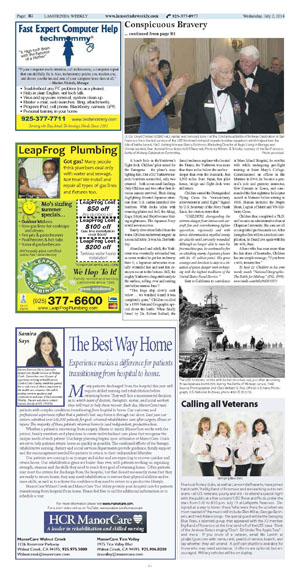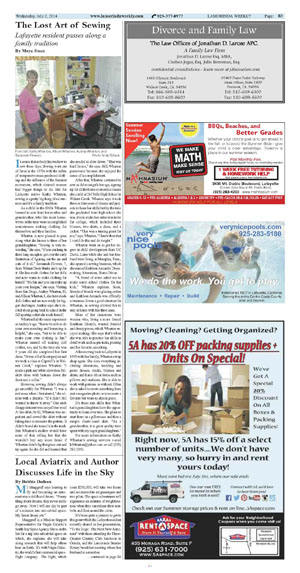|
|
Published July 2nd, 2014
|
Conspicuous Bravery
|
| The remarkable life of Lt. Col. Lloyd F. Childers |
| By Laurie Snyder |
 |
| Lloyd Childers (left) joined his brother, Wayne, aboard the Yorktown in March 1942. A third brother, Lyon, served as a cadet in the Army Air Corps. Photo courtesy Lloyd Childers |
“Japan was on a roll. The Philippines had fallen … Bataan and Corregidor …the supposedly ‘impregnable fortress’ of Singapore…. Japanese forces were advancing into Burma and might proceed to India. Even Australia appeared to be threatened. American naval forces, significantly weakened by the attack at Pearl Harbor, appeared vastly inferior to the armada that Japan was gathering to advance eastward … possibly to the Hawaiian Islands or even the West Coast.” – James R. Schlesinger, U.S. Secretary of Defense (1973-1975)
It all started for one 20-year-old sailor Dec. 7, 1941. Reading a newspaper in the radio shack of the USS Cassin, Lloyd Childers was propelled from his chair at 7:55 a.m. by several explosions. The 18-month Navy veteran raced topside in time to witness a Japanese zero scream by as Imperial Japanese Navy pilots rained death on America’s Pacific Fleet. A post-attack photo shows the Cassin capsized onto the other destroyer after fires spread between the ships. (See “Mickey Ganitch – a True Man of Honor” at http://www.lamorindaweekly.com/archive/issue0718/pdf/page%2013.pdf.)
After the dust settled, he made a beeline for his battered ship. “I went back aboard to get my wallet,” recalls Childers, now a resident of Moraga. Stuffed with 30 days’ pay, it was the sum total of his wealth. “The Cassin was at about a 45 degree angle. I was literally walking on the walls.”
By March 1942, Childers was serving with the USS Yorktown’s Torpedo Squadron Three as a rear gunner and radioman. His brother, Wayne, was also on board, but their time on the famed flattop was no pleasure cruise. They struck enemy troops on New Guinea and the Solomons, and helped sink the Shōhō.
By May 8, they were fighting in the Battle of the Coral Sea. As USS Yorktown and Lexington planes laid waste to the Shōkaku, the Japanese sent an armor-piercing bomb through the Yorktown’s flight deck, killing 50 men.
Meanwhile, code breakers back at Pearl saved the day by deciphering Japan’s plans to attack Midway – and possibly the West Coast. Told repairs to the Yorktown would take three months, Admiral Chester Nimitz gave Pearl crews just three days to fix the flattop.
Midway, June 4
Reveille sounded at 3 a.m. Breakfast was steak and eggs – proof commanders knew many would die. “We were hopelessly outnumbered,” muses Childers. Even with the Yorktown engaged, Nimitz and his staff expected only 1 out of every 5 planes to return.
“Finally, we got the call. Boy, you never heard such activity in your life.” Childers’ Devastator “dropped off the end of the carrier – 100 feet above the water,” struggling with its 2-ton payload.
Yorktown’s 12 torpedo bombers and six fighters faced a sky filled with Japanese zeroes – dreaded for their 12 to 1 kill ratios. They aimed for the Akagi, flagship of Vice Admiral Chūichi Nagumo – commander of Japan’s attack on Pearl Harbor. Planes from the USS Enterprise and Hornet hunted others from the day of infamy – the Kaga, Hiryū and Sōryū.
Ten Yorktown aircraft were destroyed at the outset. Two Japanese bullets pierced Childers’ left thigh. A third struck his ankle, shattering his right leg. A shipmate’s plane hit the water in flames.
As his pilot wove their strafed plane in and out of flak, Childers’ gun jammed – just as two more zeroes were approaching from both sides. He pulled out his pistol and fired – three quick shots at one before ripping another four at the other. The zeroes banked away quickly.
A bomb hole in theYorktown’s flight deck, Childers’ pilot aimed for the Enterprise – the plane’s nose fighting him. Out of 12 Yorktown torpedo bombers scrambled, only two returned – both ocean crash landings. Only Childers and two other first division airmen survived. Their daring dogfighting diverted Japanese attention from U.S. carrier-launched dive bombers. With decks laden with rearming planes and fuel, the Akagi, Kaga, Sōryū, and Hiryū became blazing nightmares. The Japanese Navy would never recover.
Barely alive when fished from the water, Childers underwent surgery on a mess hall table. It was his 21st birthday.
Abandoned and adrift, the Yorktown was eventually reboarded but, as crews worked to get her underway June 6, a Japanese submarine mortally wounded her and sent her destroyer escort to the bottom. Still, the mighty Yorktown clung stubbornly to the surface, rolling over and sinking just before sunrise June 7.
“This huge ship slowly sank below … we watched it until it was completely gone,” Childers recalled for a 1999 National Geographic special about the battle. When finally found by Dr. Robert Ballard, the famed undersea explorer who located the Titanic, the Yorktown was more than three miles below the surface – deeper than even the Bismarck. Just 3,000 miles from Japan, her pilot house, bridge and flight deck were still intact.
Childers earned the Distinguished Flying Cross for “extraordinary achievement in aerial flight.” Signed by U.S. Secretary of the Navy Frank Knox, the citation states that:
“CHILDERS, disregarding the extreme danger from intense anti-aircraft fire and overwhelming fighter opposition, vigorously and with heroic determination repelled enemy air attacks until seriously wounded. Although no longer able to man his free machine gun, he continued to fire on attacking enemy Japanese planes with his .45 caliber pistol. His great courage and devotion to duty in a situation of grave danger were in keeping with the highest traditions of the United States Naval Service.”
Sent to California to convalesce at Mare Island Hospital, he met his wife while undergoing pre-flight training at Saint Mary’s College. Commissioned an officer in the Marines in 1944, he became a general’s aide and gunnery instructor, flew Corsairs in Korea, and commanded the first nighttime helicopter assault in Vietnam before retiring in 1968. Honors included the Purple Heart, Legion of Merit and VN Gallantry Cross.
Childers then completed a Ph.D. and became an administrative dean at Chapman University. His sons are all accomplished professionals too. After losing his first wife to a medical complication, he found love again with his late wife, June.
A hero who has seen more than his fair share of heartache, Childers has one simple message, “If you have a wife, treasure her.”
To hear Lt. Childers in his own words, watch “National Geographic: The Battle for Midway” (PG; 1999): www.imdb.com/title/tt0264397/.

|
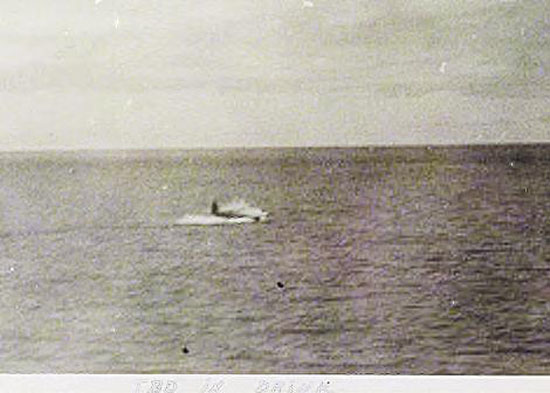 |
| "TBD in Drink," wrote Lloyd Childers on this photo taken by fellow crewman, Lieutenant Kait. "Too damaged to land aboard carrier, we land in ocean alongside the USS Monaghan." Photo courtesy Lloyd Childers |
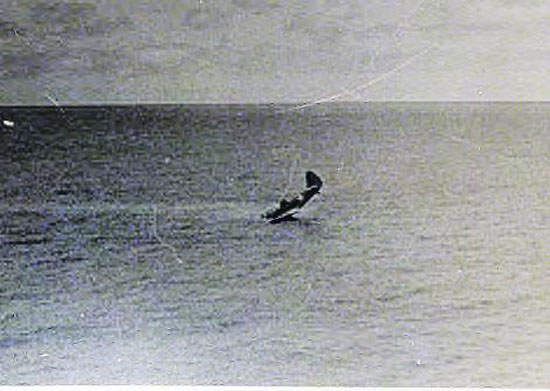 |
| |
 |
| Lt. Col. Lloyd Childers (USMC-ret.), center, was honored June 7 at the 72nd annual Battle of Midway Celebration in San Francisco. He is the last survivor of the USS Yorktown's intrepid torpedo bomber squadrons which helped turn the tide of battle June 4, 1942. Joining him was Nancy Robinson, Marketing Director at Aegis Living in Moraga, and Orinda resident, Rear Admiral Vince Anzilotti (US Navy-ret). Photo by William G. Schultz, courtesy of the San Francisco Battle of Midway Celebration Committee. Photo provided |
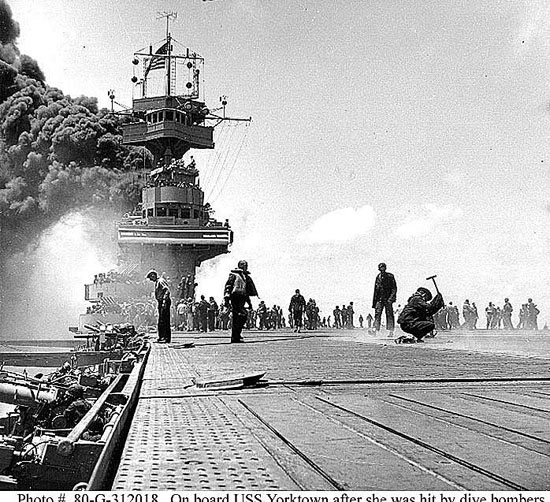 |
| The USS Yorktown, on fire with boilers knocked out, just after absorbing three Japanese bomb hits during the Battle of Midway June 4, 1942. Source: Photographer 2nd Class William G. Roy, Official U.S. Navy Photograph, U.S. National Archives, photo # 80-G-312018. |
 |
| Swinging Blue Stars |
Calling all Veterans
Five local Rotary clubs, as well as Lamorinda Presents, have joined hands with The Big Band of Rossmoor and are reaching out to veterans – all U.S. veterans, young and old – to attend a special night with the public at a free concert/ USO Show and Picnic under the stars from 5:30 to 8:30 p.m. July 19 at Lafayette Reservoir. Designed as a way to honor those “who were there for us when we most needed it,” the music will include Glen Miller, George Gershwin, and Fred Astaire songs. The special guest will be the Swinging Blue Stars, a talented group that appeared with the 32-member Big Band of Rossmoor at the final send-off of the USS Iowa. Think of the Andrew Sisters singing “Don’t Sit Under The Apple Tree” – and more. If you know of a veteran, email Mo Levich at gto@67goat.com with name, rank, year(s) of service, branch, and say whether they will attend. A golf cart shuttle is available for those who may need assistance. Uniforms are optional, but encouraged. Military vehicles will be on display. |
| |
|
|
|









